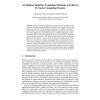Free Online Productivity Tools
i2Speak
i2Symbol
i2OCR
iTex2Img
iWeb2Print
iWeb2Shot
i2Type
iPdf2Split
iPdf2Merge
i2Bopomofo
i2Arabic
i2Style
i2Image
i2PDF
iLatex2Rtf
Sci2ools
DBSEC
2008
2008
An Opinion Model for Evaluating Malicious Activities in Pervasive Computing Systems
Pervasive computing applications typically involve cooperation among a number of entities spanning multiple organizations. Any security breach in any single entity can have very far-reaching consequences. In addition, a number of factors make the task of defending against malicious attacks in pervasive systems even more complex than conventional systems. Foremost among them is that a significant number of the devices deployed in such environments are frequently severely resource constrained. Thus strong security controls cannot be easily deployed on these devices. A second factor is that since a large number of such devices are also involved, attacks can propagate very fast in pervasive environments. These prompt us to propose a model for predicting malicious activities in pervasive systems. Our model is based on a logic of opinion that has been proposed elsewhere. Ours is not an intrusion detection system for pervasive systems but works in tandem with one. The system we propose can be...
Database | DBSEC 2008 | Pervasive Computing Applications | Pervasive Environments | Pervasive Systems |
| Added | 29 Oct 2010 |
| Updated | 29 Oct 2010 |
| Type | Conference |
| Year | 2008 |
| Where | DBSEC |
| Authors | Indrajit Ray, Nayot Poolsappasit, Rinku Dewri |
Comments (0)

